publications
2024
-
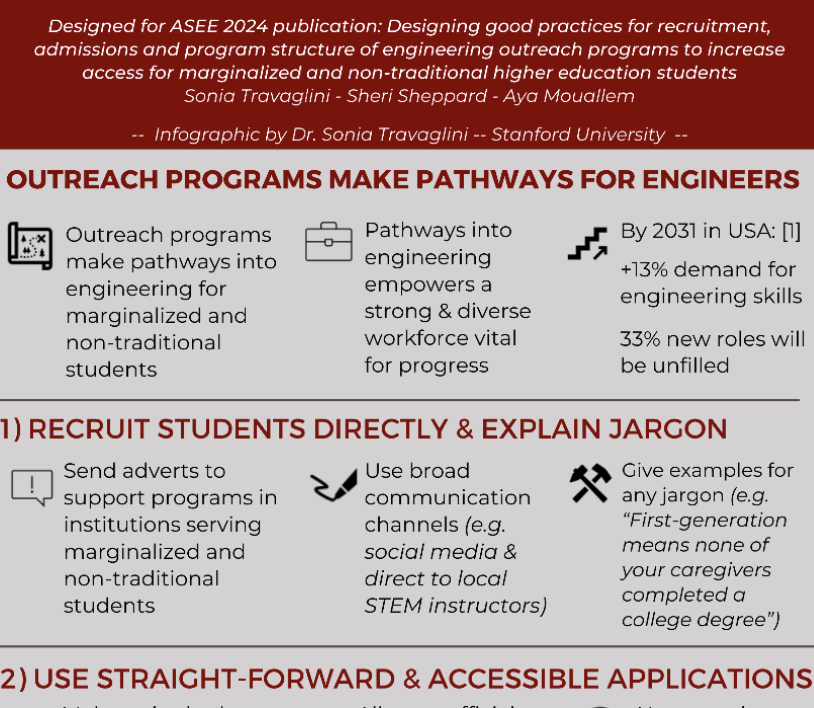 Designing Good Practices for Recruitment, Admissions, and Program Structure of Engineering Outreach Programs to Increase Access for Marginalized and Non-Traditional Higher Education StudentsS. Travaglini, A. Mouallem, and S. D. SheppardThe American Society for Engineering Education (ASEE) Annual Conference & Exposition, Portland, OR, USA, 2024
Designing Good Practices for Recruitment, Admissions, and Program Structure of Engineering Outreach Programs to Increase Access for Marginalized and Non-Traditional Higher Education StudentsS. Travaglini, A. Mouallem, and S. D. SheppardThe American Society for Engineering Education (ASEE) Annual Conference & Exposition, Portland, OR, USA, 2024Engineering outreach programs aimed at students in higher education play a key role in providing pathways for students to access studies and careers in engineering. Marginalized and non-traditional students may not have the resources to represent their skills, goals and fit in the parlance and format that best matches program requirements and expectations, particularly during recruitment and admissions. This lack of knowledge of this ‘hidden curriculum’ can result in barriers to accessing and participating in outreach programs, despite the programs being designed to serve and actively seeking these underserved student populations. This paper presents a literature review that identifies good practices for the equitable design and implementation of outreach programs in engineering higher education that help lower these barriers and increase access. The paper also thematically analyzes two case studies of outreach programs that create pathways into engineering in the United States, and that have been designed to address these barriers, to describe good practices for recruitment strategies, equitable admissions & selection processes, and program design. The two case studies consist of an online program designed for computer science and engineering students, and an in-person program designed for aerospace students at community colleges. Insights will be gained by qualitatively analyzing program materials and staff perspectives for the purpose of improving program quality. The paper uses the literature research and the insights gained from the case studies, to extract a set of practices that would be of interest to designers of similar engineering outreach programs that serve marginalized and non-traditional students in higher education.
-
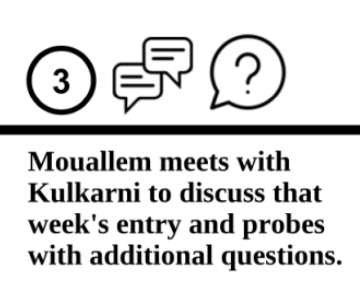 Leveraging the CARE Methodology to Enhance Pedagogical and Institutional Support for Blind or Low-Vision (BLV) Learners in Electrical and Computer Engineering (ECE) **Best Diversity, Equity, and Inclusion Paper AwardA. Mouallem, T. Kulkarni, and S. D. SheppardThe American Society for Engineering Education (ASEE) Annual Conference & Exposition, Portland, OR, USA, 2024
Leveraging the CARE Methodology to Enhance Pedagogical and Institutional Support for Blind or Low-Vision (BLV) Learners in Electrical and Computer Engineering (ECE) **Best Diversity, Equity, and Inclusion Paper AwardA. Mouallem, T. Kulkarni, and S. D. SheppardThe American Society for Engineering Education (ASEE) Annual Conference & Exposition, Portland, OR, USA, 2024There is a growing, yet relatively limited body of research exploring the experiences of learners with disabilities in introductory electrical and computer engineering (ECE) education. With the proven importance of introductory ECE education in influencing students’ undergraduate interests and future career prospects in technology, the inaccessibility of the field to learners with disabilities poses an inequitable access barrier that further marginalizes these learners, often preventing them from exploring the field in the first place. In particular, as ECE largely relies on visual cues for designing, building, testing, and debugging hardware systems, ECE education is significantly inaccessible to learners who are blind or have low vision (BLV). Thus, it is imperative that we assess and evaluate any accounts of blind ECE learners to critically redesign ECE pedagogy to meet their preferences and needs and prioritize their inclusion. The Challenging and Rewarding Experiences (CARE) methodology is a recent framework that promotes an in-depth assessment of student-centric perspectives on ECE course offerings, with the intention of informing instructors of necessary change to be introduced to the course offerings to improve students’ experiences and align their expectations with the planned course objectives. In this paper, we apply the CARE methodology to conduct a comprehensive analysis of the autoethnographic account of the first blind student to complete the introductory ECE course at our institution, Stanford University. This work also expands the role of the blind student to become a co-researcher, actively guiding the direction of this work while receiving mentorship from research team members on qualitative research methods. In this work, we begin with the analysis of seven reflection journal entries written by the blind student and relevant discussion session notes recorded by the lead researcher. These data were generated and collected via the autoethnography method and analyzed by applying the CARE methodology, using a grounded theory approach, during which we completed open and focused coding. We then identify intersecting Challenging And Rewarding Experiences (CARE) areas that the blind learner faced in the introductory ECE course. Next, we compare these CARE areas to those that emerged from studying a group of 42 sighted students taking the same course with the same resources, as published in prior work. This comparison leads us to identify a new, fourth lens for the CARE methodology– namely, inequitable challenges, faced by the blind learner due to the inherent ableism of ECE education and the inaccessibility of its available resources (this is in addition to the original three lenses of the methodology: rewarding experiences, unproductive struggle, and healthy challenges). Consequently, based on the newly identified CARE lens in this work, we propose a preliminary list of good practices for inclusive institutional and pedagogical support for BLV learners pursuing introductory ECE education. We also believe that the CARE methodology can be used to amplify the voices of other ECE students with different disabilities to inform systemic change for inclusive ECE education.
2023
-
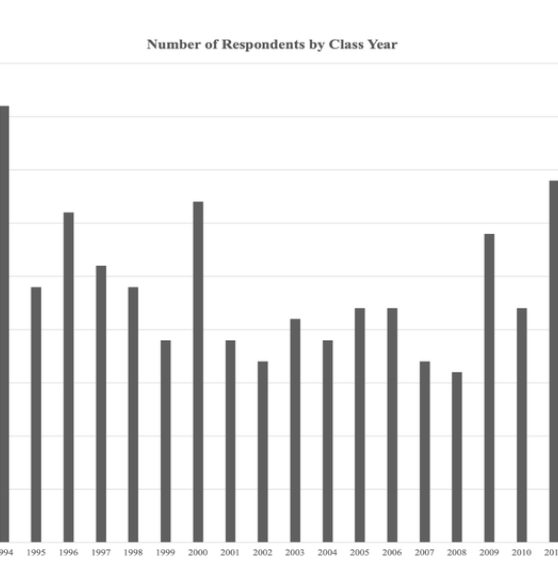 The Nexus of Entrepreneurship and Innovation: A new approach to looking at the creative contributions of engineering graduatesF. Kempf, N. Elfiki, A. Mouallem, H. L. Chen, G. Toye, and 4 more authorsThe American Society for Engineering Education (ASEE) Annual Conference & Exposition, Baltimore, MD, USA, 2023
The Nexus of Entrepreneurship and Innovation: A new approach to looking at the creative contributions of engineering graduatesF. Kempf, N. Elfiki, A. Mouallem, H. L. Chen, G. Toye, and 4 more authorsThe American Society for Engineering Education (ASEE) Annual Conference & Exposition, Baltimore, MD, USA, 2023Engineers are called upon to possess strong analytical and communication skills, exhibit practical ingenuity, and be creative thinkers, all the while upholding high ethical standards. In more recent times they are also expected to be innovative and entrepreneurial. We see this in large companies working to incentivize their engineers to contribute to product innovation through, for example, involvement in makerspaces, hackathons, and design sprints. We see it in universities in their offering stand-alone courses on product innovation and entrepreneurship for their engineering students, integrating innovative and entrepreneurial ideas into existing technical courses, and creating a variety of extra-curricular activities to put those ideas into play. At the same time, the concepts of innovation and entrepreneurship are generally treated and explored as distinct areas of research; as such, distinct and separate measures of an individual’s self-efficacy and associated behaviors have been developed. In this work we take a different tack, wanting to identify the nexus, or common ground, of Innovative and Entrepreneurial self-efficacies, and Innovative and Entrepreneurial behaviors. Thinking about common ground is a useful lens with which to look at the intentional or focused creativity of engineers, whether they are working in new or existing enterprises. First, we show the development of this intersectional/nexus concept (which we call Embracing New Ideas, ENI) in terms of measures of self-efficacy (ENI-SE; consisting of six items, with a Cronbach’s Alpha of .85) and behavior (ENI-B; consisting of five items, with a Cronbach’s Alpha of .80). Then based on Social Cognitive Career Theory (SCCT), we model ENI-B (our dependent variable) as a function of ENI-SE and a variety of workplace and work-assignment features, as well as demographics. Our data for developing these new Self-Efficacy and Behavior Constructs, and creating a descriptive model comes from a sample of over 700 engineering alumni working in a variety of roles and job functions. Results from linear regression models show that over 55 percent of the variability in ENI-B is explained by a combination of self-efficacy and contextual or workplace factors. These results begin to establish a solid foundation for subsequent work that explores educational experiences that contribute to engineering students developing self-efficacy in Embracing New Ideas, and workplace settings that truly enable behaviors related to Embracing New Ideas.
-
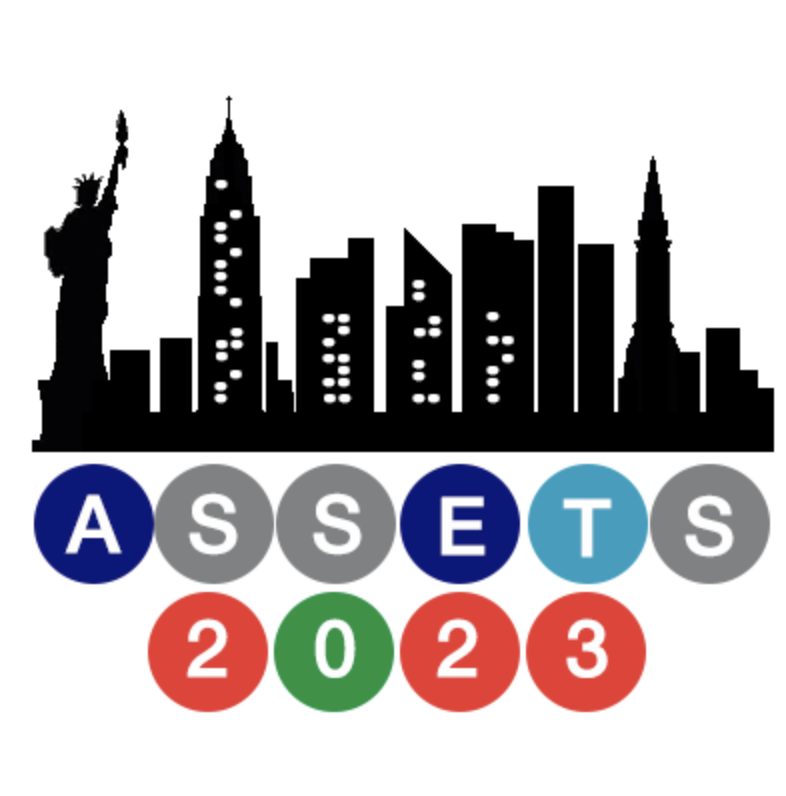 A Case for Improving the Accessibility of Electrical and Computer Engineering Education – Starting with a Blind Student’s AutoethnographyG. S-H Kim, T. Kulkarni, and A. MouallemThe 25th International ACM SIGACCESS Conference on Computers and Accessibility (ASSETS), New York, NY, USA, 2023
A Case for Improving the Accessibility of Electrical and Computer Engineering Education – Starting with a Blind Student’s AutoethnographyG. S-H Kim, T. Kulkarni, and A. MouallemThe 25th International ACM SIGACCESS Conference on Computers and Accessibility (ASSETS), New York, NY, USA, 2023Electrical and computer engineering (ECE) theory and tooling are foundational prerequisites for learners’ success in designing and building systems (so called “making” activities) and in several STEM majors in higher education. However, ECE education remains significantly inaccessible to students who are blind or have low vision (BLV), due to the field’s weighty reliance on visual content. In this work, we reflect on the autoethnographic account of the first blind student to complete the introductory ECE and making course at our educational institution, identifying three main areas pertaining to the overarching theme of inequitable challenges, including the student’s experiences with (1) conceptual learning and tooling, (2) translating theory into practice, and (3) experimenting with learning methods and approaches. We then bring together our findings, previous works, and existing tools to propose a preliminary list of design considerations to inform the development of future accessible tools for ECE education and reduce access barriers to the field.
-
 The CARE methodology: A new lens for introductory ECE course assessment based on student challenging and rewarding experiencesA. Mouallem, M. Horowitz, and S. D. SheppardThe American Society for Engineering Education (ASEE) Annual Conference & Exposition, Baltimore, MD, USA, 2023
The CARE methodology: A new lens for introductory ECE course assessment based on student challenging and rewarding experiencesA. Mouallem, M. Horowitz, and S. D. SheppardThe American Society for Engineering Education (ASEE) Annual Conference & Exposition, Baltimore, MD, USA, 2023Introductory Electrical and Computer Engineering (ECE) education is of great importance to students interested in exploring the field, as it introduces them to the fundamental conceptual understanding of the governing laws and theories of ECE, as well as to indispensable hands-on lab skills to apply theory in practice. These learning outcomes lay a strong foundational base that proves crucial throughout students’ journeys in and beyond academia and in a variety of technical disciplines as well. To ensure these valuable outcomes are met, introductory ECE educators invest significant effort in course assessment and improvement. Such efforts have been documented in literature, including developing new lab tools, incorporating project-based learning, and proposing new course assessment methodologies and educational interventions. Adopting a student-centric lens, we propose a new methodology for early ECE course assessment called CARE, referring to the intersecting areas of the most Challenging And Rewarding Experiences that students have had in line with the main course objectives. This new assessment lens provides a fertile ground to amplify students’ rewarding experiences, minimize their unproductive struggle, and preserve healthy challenges that effectively contribute to the students’ learning process. In our work, we apply the CARE methodology in studying a population of 42 students enrolled in the introductory ECE course, ENGR 40M: An Intro to Making: What is EE, offered at our educational institution, Stanford University. This course was chosen for this study as it emphasizes the importance of integrating theoretical and laboratory exposure to introductory ECE concepts via immersive project-based learning opportunities. Our main contributions begin with the development of the CARE methodology, its application to assess an introductory ECE course at our academic institution, and the generation of recommendations to improve introductory ECE education at our institution. As a first step in the proposed methodology, we conducted comprehensive needfinding – a human-centered design method – by collecting quantitative and qualitative feedback on the student experience, complemented by instructors’ insights. Next, using a grounded theory approach to analyze our data, we uncovered five main areas of intersecting challenging and rewarding experiences, spanning the different theoretical and lab components of the course curriculum. We then offered recommendations to the course instructors to improve the student course experience in every area while being mindful of the effort required and time commitment on the instructors’ and students’ behalf. Furthermore, we discussed how this methodology can serve as a new approach to satisfy the ABET Criterion 4 for continuous assessment efforts. Finally, we believe that this methodology is generalizable and can scale to assess and improve students’ experiences in introductory courses in a variety of engineering disciplines as well.
-
 Decades of Alumni: Perspectives on the Impact of Project-Based Learning on Career Pathways and Implications for Design EducationS. D. Sheppard, H. L. Chen, G. Toye, A. Mouallem, M. Lande, and 5 more authors2023
Decades of Alumni: Perspectives on the Impact of Project-Based Learning on Career Pathways and Implications for Design EducationS. D. Sheppard, H. L. Chen, G. Toye, A. Mouallem, M. Lande, and 5 more authors2023This chapter summarizes four interview-based studies exploring the impact of two graduate-level courses in mechanical engineering at Stanford University on the innovative, entrepreneurial, and collaborative capacities of alumni and, in particular, the innovative career pathways of female graduates. The research findings are situated in two frameworks: (1) the social cognitive career theory (SCCT), a well-established model of how basic academic and career interests develop and how academic and career success is obtained, and (2) the academic-workplace relational (AWR) model, a new model developed to describe the many bidirectional relationships observed between university and workplace settings. Finally, the continuing research efforts identifying how project-based learning prepares individuals for career success and how project-based learning can be improved and strengthened are outlined.
2022
-
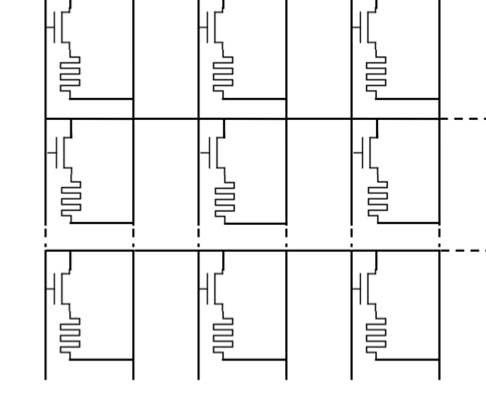 1T1R In-Memory Compute for Winner Takes All Application in Kohonen Neural NetworksA. Mouallem, H. Fadlallah, L. Bacha, D. El Hajj, R. Jamil, and 2 more authorsIEEE International Symposium on Circuits and Systems (ISCAS),, 2022
1T1R In-Memory Compute for Winner Takes All Application in Kohonen Neural NetworksA. Mouallem, H. Fadlallah, L. Bacha, D. El Hajj, R. Jamil, and 2 more authorsIEEE International Symposium on Circuits and Systems (ISCAS),, 2022In-memory computing is a promising candidate for overcoming the von Neumann memory wall and accelerating data processing in neural network applications. We propose a ITIR-based approach to carry out an efficient in-memory computation of the minimum logic function to be executed in the form of a series of 1-bit search operations similar to modern associative processors. We study the proposed design in the context of Kohonen Neural Networks that are also known as self-organizing maps. They are based on competitive learning where the minimum-search operation is a crucial part in the learning process. We study the trade off of different low-to-high resistance state windows associated with different endurance levels in the presence of process variations. We demonstrate 0-4% reduction in the MNIST test dataset accuracy for the different scenarios. We report a maximum of 6fJ for the 1-bit search operation.